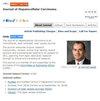有肝细胞癌和没有肝细胞癌的肝硬化患者诊断前血清代谢组学和脂质组学特征的差异
IF 4.2
3区 医学
Q2 ONCOLOGY
引用次数: 0
摘要
背景:早期检测肝细胞癌(HCC)对改善患者预后至关重要,但我们缺乏可靠的临床生物标志物。本研究旨在确定用于早期检测 HCC 的代谢物和/或脂质面板:方法:我们开发了一种基于高分辨率液相色谱质谱(LC-MS)的分析平台,并评估了28份诊断前血清样本(来自随后发展为HCC的肝硬化患者(病例))与30份样本(来自无HCC的肝硬化患者(对照组))之间的全局代谢组和脂质组的差异。我们将差异表达的代谢物和脂质与公开数据集中的相关基因、蛋白质和转录组特征联系起来。我们使用机器学习模型确定了区分病例和对照组的最小面板:结果:与对照组相比,病例中有124种代谢物和246种脂类上调,208种代谢物和73种脂类下调。上调最多的代谢物是糖脱氧胆酸、5-甲基四氢叶酸、辛酰辅酶 A 和甘氨胆酸。升高的脂质包括甘油脂质、心磷脂和磷脂酰乙醇胺,而抑制的脂质包括氧化磷脂酰胆碱和溶血磷脂。差异表达的代谢物和脂质与之前发表的转录组特征有重叠,这说明它们与肝病的严重程度有关。支持向量机的接收器工作曲线下面积为 0.98(四分位间范围为 0.9-1),由此得出结论:12 种代谢物组成的小组能够区分病例和对照组:通过使用诊断前血清样本,我们发现了一个很有前景的代谢物面板,它能准确识别进展为 HCC 的肝硬化患者。我们还需要对这一面板进行进一步验证。本文章由计算机程序翻译,如有差异,请以英文原文为准。
Differences in Prediagnostic Serum Metabolomic and Lipidomic Profiles Between Cirrhosis Patients with and without Incident Hepatocellular Carcinoma
Background: Early detection of hepatocellular carcinoma (HCC) is crucial for improving patient outcomes, but we lack robust clinical biomarkers. This study aimed to identify a metabolite and/or lipid panel for early HCC detection.
Methods: We developed a high-resolution liquid chromatography mass spectrometry (LC-MS)-based profiling platform and evaluated differences in the global metabolome and lipidome between 28 pre-diagnostic serum samples from patients with cirrhosis who subsequently developed HCC (cases) and 30 samples from patients with cirrhosis and no HCC (controls). We linked differentially expressed metabolites and lipids to their associated genes, proteins, and transcriptomic signatures in publicly available datasets. We used machine learning models to identify a minimal panel to distinguish between cases and controls.
Results: Among cases compared with controls, 124 metabolites and 246 lipids were upregulated, while 208 metabolites and 73 lipids were downregulated. The top upregulated metabolites were glycoursodeoxycholic acid, 5-methyltetrahydrofolic acid, octanoyl-coenzyme A, and glycocholic acid. Elevated lipids comprised glycerol lipids, cardiolipin, and phosphatidylethanolamine, whereas suppressed lipids included oxidized phosphatidylcholine and lysophospholipids. There was an overlap between differentially expressed metabolites and lipids and previously published transcriptomic signatures, illustrating an association with liver disease severity. A panel of 12 metabolites that distinguished between cases and controls with an area under the receiver operating curve of 0.98 for the support vector machine (interquartile range, 0.9– 1).
Conclusion: Using prediagnostic serum samples, we identified a promising metabolites panel that accurately identifies patients with cirrhosis who progressed to HCC. Further validation of this panel is required.
Methods: We developed a high-resolution liquid chromatography mass spectrometry (LC-MS)-based profiling platform and evaluated differences in the global metabolome and lipidome between 28 pre-diagnostic serum samples from patients with cirrhosis who subsequently developed HCC (cases) and 30 samples from patients with cirrhosis and no HCC (controls). We linked differentially expressed metabolites and lipids to their associated genes, proteins, and transcriptomic signatures in publicly available datasets. We used machine learning models to identify a minimal panel to distinguish between cases and controls.
Results: Among cases compared with controls, 124 metabolites and 246 lipids were upregulated, while 208 metabolites and 73 lipids were downregulated. The top upregulated metabolites were glycoursodeoxycholic acid, 5-methyltetrahydrofolic acid, octanoyl-coenzyme A, and glycocholic acid. Elevated lipids comprised glycerol lipids, cardiolipin, and phosphatidylethanolamine, whereas suppressed lipids included oxidized phosphatidylcholine and lysophospholipids. There was an overlap between differentially expressed metabolites and lipids and previously published transcriptomic signatures, illustrating an association with liver disease severity. A panel of 12 metabolites that distinguished between cases and controls with an area under the receiver operating curve of 0.98 for the support vector machine (interquartile range, 0.9– 1).
Conclusion: Using prediagnostic serum samples, we identified a promising metabolites panel that accurately identifies patients with cirrhosis who progressed to HCC. Further validation of this panel is required.
求助全文
通过发布文献求助,成功后即可免费获取论文全文。
去求助

 求助内容:
求助内容: 应助结果提醒方式:
应助结果提醒方式:


